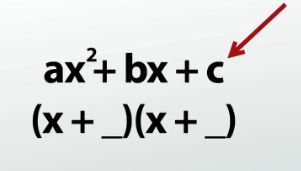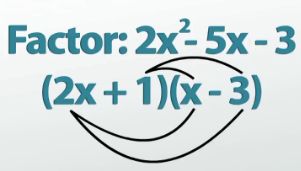Factoring Quadratic Equations: Polynomial Problems with a Non-1 Leading Coefficient
After you watch the video and know the material, click HERE for the quiz.
Once you get good at factoring quadratics with 1x squared in the front of the expression, it's time to try ones with numbers other than 1. It will be the same general idea, but there are a few extra steps to learn. Do that here!
Factoring Quadratic Equations
This lesson will be on advanced factoring techniques, so I'm going to assume that you know a few things: first, that factoring is the process of breaking up a number into the things that we can multiply together to get that number. This means that factoring a quadratic expression is the process of taking a trinomial and turning it into multiplication of two binomials - basically FOIL backwards. We do this by looking for a pair of numbers that have a product equal to the constant on the end of the trinomial and a sum equal to the coefficient on the x's. For example, turning x^2 - 3x - 10 into (x + 2)(x - 5) by realizing that 2 * -5 = -10, and 2 + -5 = -3.
 |
So, where do we go from here? What else is there to know? Well, the method I just described only works for quadratic trinomials where the leading coefficient (the number in front of the x squared) is equal to 1. As soon as we're asked to factor something else, like 2x^2 - 5x - 3, we're going to be in trouble. The goal is still the same - split the trinomial into a product of binomials - and we'll still find a lot of the same patterns, but now we'll have to make two slight changes in the process in order to end up with the correct answer. Let's go ahead and take a look at the example I just mentioned.
Adjusting the Pattern
Factor 2x^2 - 5x - 3.
We'll start this problem very similarly to the simple factoring problems by looking for two numbers that fit the pattern. The thing is, it's not going to be quite the same pattern. One part stays the same, and that is the fact that we need to find a pair of numbers that will add up to the middle coefficient - in this case, -5. But the second part is going to be different. Instead of our two numbers needing to have a product equal to the constant on the end, we now need the product of our pair of numbers to be equal to the constant on the end times the leading coefficient. This was actually true for the easier factoring problems as well, but the leading coefficient was just 1, so multiplying by 1 didn't change what the number was.
The next step of the problem should be familiar. Find a pair of numbers that has a sum of -5 and a product of -6. Making a quick list of the factor pairs of 6 and keeping in mind that we'll need one to be positive and one to be negative, makes it clear that -6 and +1 are our two winners. And now we come to the only other difference in our process. Instead of simply being able to say -6 and +1 go in our binomials and we're done, there is an extra step before we can be sure of our answer. While there are multiple ways of doing this step, I recommend using the area method to work your way backward to the answer. Putting the 2x^2 and the -3 in one diagonal of the chart and the two values we came up with using our pattern attached with x's in the other diagonal, gets us one step away from our answer.
| 2x^2 | -6x |
| x | -3 |
If we can find what terms must have been on the outside of this chart to get multiplied in and give us what we have here, we'll be done. We do this by dividing out the greatest common factor from each row and column of our chart. So, if I look at the top row of this chart, I have a 2x^2 and -6x. I need to ask myself what do those things have in common? Well, 2 and 6 are both divisible by 2, so I can take out a 2. But they also both have an x, which means I also take out an x, so I can pull a 2x to the outside of that row. Going down a row to the bottom, 1x and -3, they don't have any factors with the numbers in common, and they also don't have any variables in common, which means the only thing I can divide out is a 1. Now, we go to the columns. Let's start in the left column, 2x^2 and 1x. The numbers don't have anything in common but the variables do, which means I can take out 1x. Finally, the column on the right: -6x and -3. Both share a -3, which means I divide that out and write it on top. What we now have on the left and above our little area model is our factored answer. The terms that are on the same side are the terms that go in parentheses together to make up our two binomials, and I end up with (2x + 1)(x - 3). You can always quickly multiply out your answer to make sure you got the right thing, and if you do that here, looks like we're good.
Factoring quadratics like this take a while, and they're not always simple, so practice is key. Let's do one more example during this lesson.
 |
Another Example
Factor 9x^2 - 4.
Not only is this example another one with a non-1 leading coefficient, it's also an example of a special quadratic that often messes students up. Why? Because there are no x's in the middle! It's not a trinomial! But that's okay. Just think of this problem as being this one: Factor 9x^2 + 0x - 4. Now we're ready to go. We begin by finding the two numbers that fit the pattern. For this one, they'll have to add up to zero (the middle term) and multiply to -36, which was the 9 in front times the -4 on the end. Quickly looking through our options here and knowing that we're going to have to add up to zero makes it pretty obvious that 6 and -6 are going to be our winners. Now that we have these two values, we can fill in our area model. We put the 9x^2 and the -4 in one diagonal and the 6x and -6x in the other, but it actually doesn't matter which diagonal or even which order you put them in; they're all going to work! Lastly, we need to divide out the greatest common factors from each row and column to find out which binomials exist on the outside of this chart.
| 9x^2 | -6x |
| 6x | 4 |
 |
Looking at the top row, it looks like they both have a 3 and an x. The bottom row, both numbers are divisible by 2. The left column, I see a 3 and an x again, and the right column, they both have a -2 so I can pull that out. Rewriting the terms from each side together in parentheses as binomials says that the factored form of this is (3x + 2)(3x - 2).
Lesson Summary
Factoring problems with a leading coefficient that isn't 1 have two differences from their simpler counterparts. First, the pattern we use to determine the pair of numbers that will help us find our answer now requires you to find two numbers that have a product equal to the constant times the leading coefficient, instead of simply being the leading coefficient itself like before.
Secondly, once you come up with the pair of numbers that fit the pattern, you must substitute those numbers into an area model and factor out the greatest common factors to determine the answer. If you're asked to factor a quadratic that does not have an x term, just pretend that there is a 0x term in the middle there, and continue to do the problem just like you normally would.